问题场景:
最近在做JavaWeb课程的实验课,今天在尝试jsp通过jdbc连接数据库向MySQL中的user表插入数据后,表内数据出现了中文乱码的问题。下面将详细给出本次问题出现场景以及详细的解决方案。
问题描述
在我的MySQL中的数据库db1里,有一个名为“user”的表,其属性值如下:
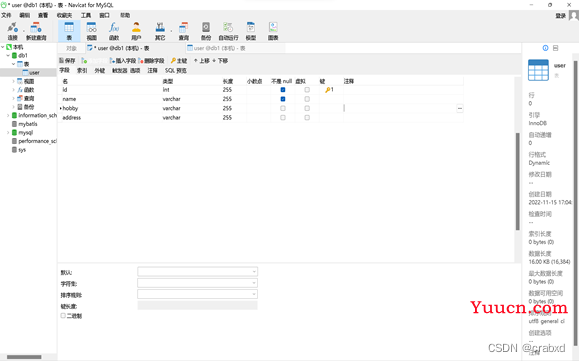
通过navicat向表格中添加一条记录,
用jsp文件查看,可以看到中文能够正常显示。

但是通过jsp文件向数据库插入记录时,便会出现乱码。
向数据库插入一条新记录的代码如下:
<%@ page language="java" contentType="text/html; charset=utf-8" pageEncoding="UTF-8"%>
<%@ page import="java.sql.*"%>
<html>
<head>
<title>通过JDBC连接对user表进行操作</title>
</head>
<%
try {
Class.forName("com.mysql.jdbc.Driver"); //驱动程序名
String url = "jdbc:mysql://127.0.0.1:3306/db1?useUnicode=true&characterEncoding=UTF-8"; //数据库名
String username = "root"; //数据库用户名
String password = xxxx; //数据库用户密码
Connection conn = DriverManager.getConnection(url, username, password); //连接状态
//各个value值
int id =2;
String name = "李四";
String hobby = "吃饭";
String address = "广州";
if(conn != null){
out.print("数据库连接成功!");
out.print("<br />");
String sql = "INSERT INTO USER(id,name,hobby,address) VALUES(?,?,?,?);"; //查询语句
//获取pstmt对象
PreparedStatement pstmt = conn.prepareStatement(sql);
//设置参数
pstmt.setInt(1,id);
pstmt.setString(2,name);
pstmt.setString(3,hobby);
pstmt.setString(4,address);
//执行sql
int count=pstmt.executeUpdate();//影响的行数
//处理结果
System.out.println(count>0);
//释放资源
pstmt.close();
conn.close();
}
else{
out.print("连接失败!");
}
}catch (Exception e) {
out.print("数据库连接异常!");
}
%>
</body>
</html>
通过navicat查看新插入的数据,发现传入的中文全部变成乱码(问号)了,如下图所示。
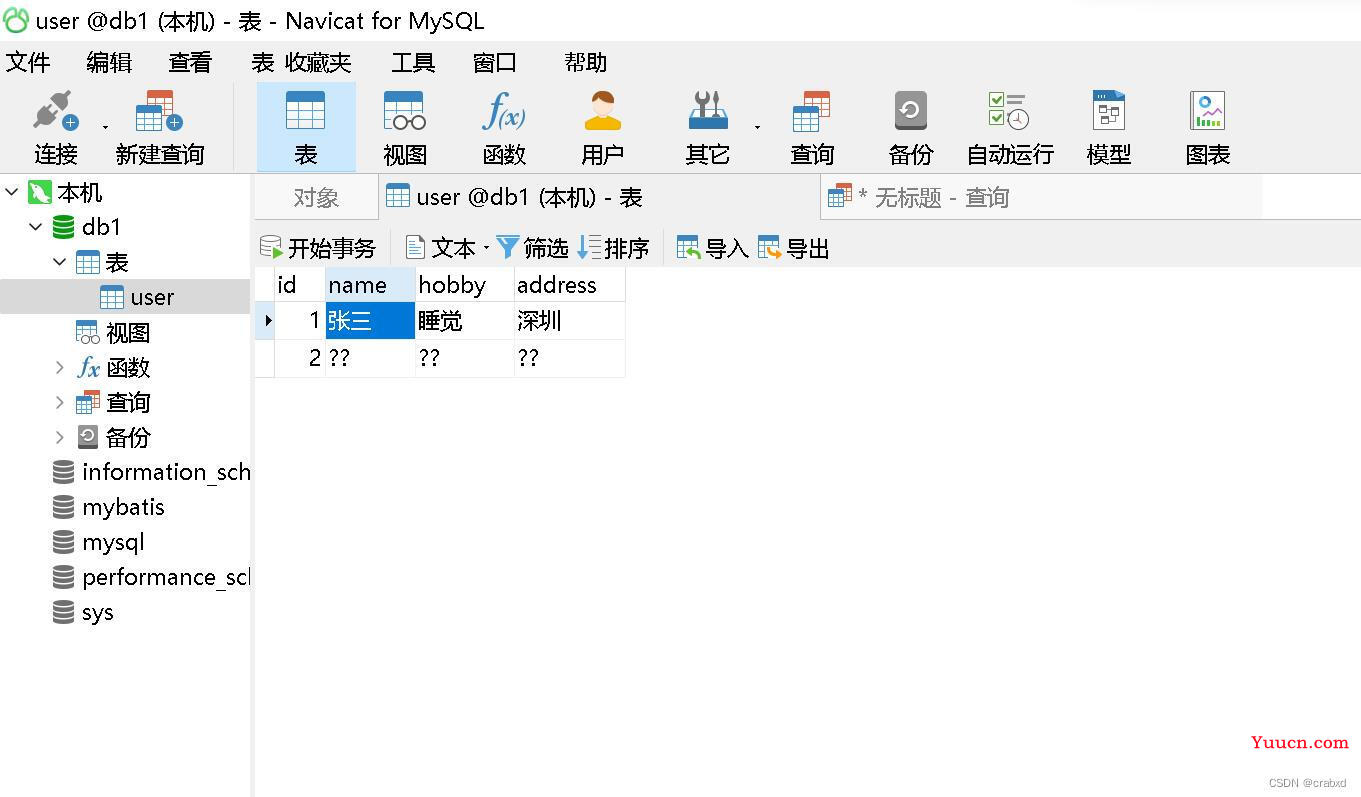
原因分析以及疑惑:
一般遇到出现乱码的情况,我们都会猜测是编码问题。于是我检查了一下,我的jsp文件使用的是utf-8编码,数据库db1使用的也是utf8,这两者是一样的,为何还会出现乱码的情况呢?
解决过程:
刚开始,我的代码中是的url是:
String url = "jdbc:mysql://127.0.0.1:3306/db1"
后来,我给它加上了参数,确保其是使用utf-8编码,如下:
String url = "jdbc:mysql://127.0.0.1:3306/db1?useUnicode=true&characterEncoding=UTF-8";
但是很遗憾,并没有解决问题,文件中的中文字符传入到user表中依旧是乱码,所以该方法不能行得通。
于是我新建了个查询,显示各部分所采用的编码方式,查询语句如下:
SHOW VARIABLES LIKE 'CHARACTER%';
查询的结果如下:
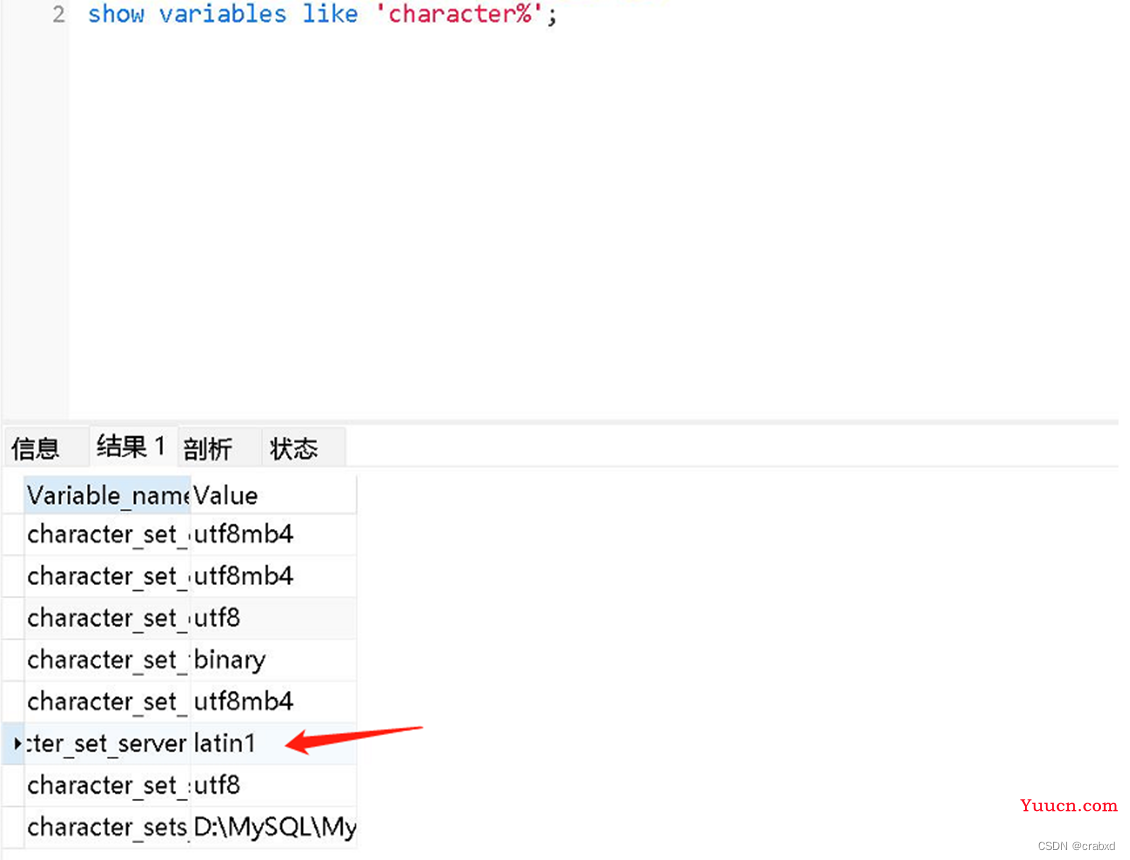
可以看到,这里面这个character_set_server鹤立鸡群,独独使用了Latin1(那个用binary的不算,那是bin文件用的)。
Latin1是MySQL的默认编码,ISO-8859-1的别名,单字节编码,向下兼容ASCII,其编码范围是0x00-0xFF,0x00-0x7F之间完全和ASCII一致,0x80-0x9F之间是控制字符,0xA0-0xFF之间是文字符号。
它包括西欧语言、希腊语、泰语、阿拉伯语、希伯来语对应的文字符号,但是它不支持中文。所以,直觉告诉我出现问题的地方找到了。
通过上网查询,我了解这是输入到数据库字符的编码,确定是因为此处编码问题导致出现。
于是我使用语句
set @@character_set_server='utf8';”
修改其编码,修改之后再次执行“show variables like ‘character%’;”语句,可以看到它的编码确实被改为utf8。
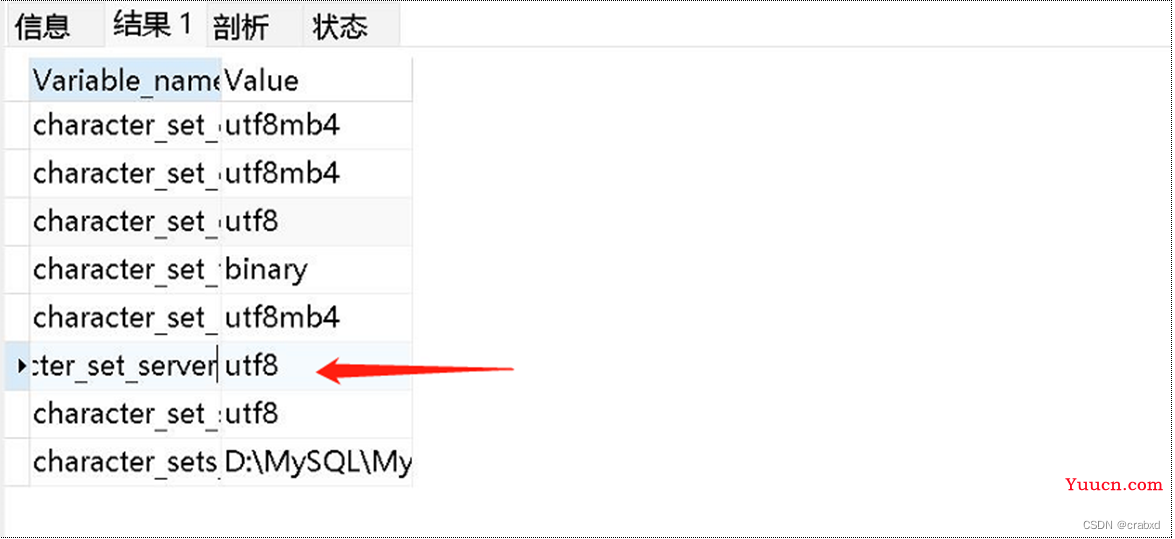
于是我以为问题解决了,便将原先乱码的记录删除,再次运行insert.jsp文件测试向user表插入数据是否会出现乱码。
出乎意料的是,插入的数据依旧是乱码。经过多次刷新和尝试后依旧如此。
于是我重启了我的MySQL,重启后再次查看character_set_server的编码,发现其再次变为Latin1。
我觉得可能是因为配置文件的原因,于是我找到了我的MySQL配置文件my.ini。
该文件是MySQL数据库的配置文件,可以通过修改它来更新MySQL的配置。找到其中character-set-server(如下图所示),可以看到其并未指定编码,所以其还是使用默认的编码,当我们重启后,做出的修改并没有在配置文件中,所以修改会失效。
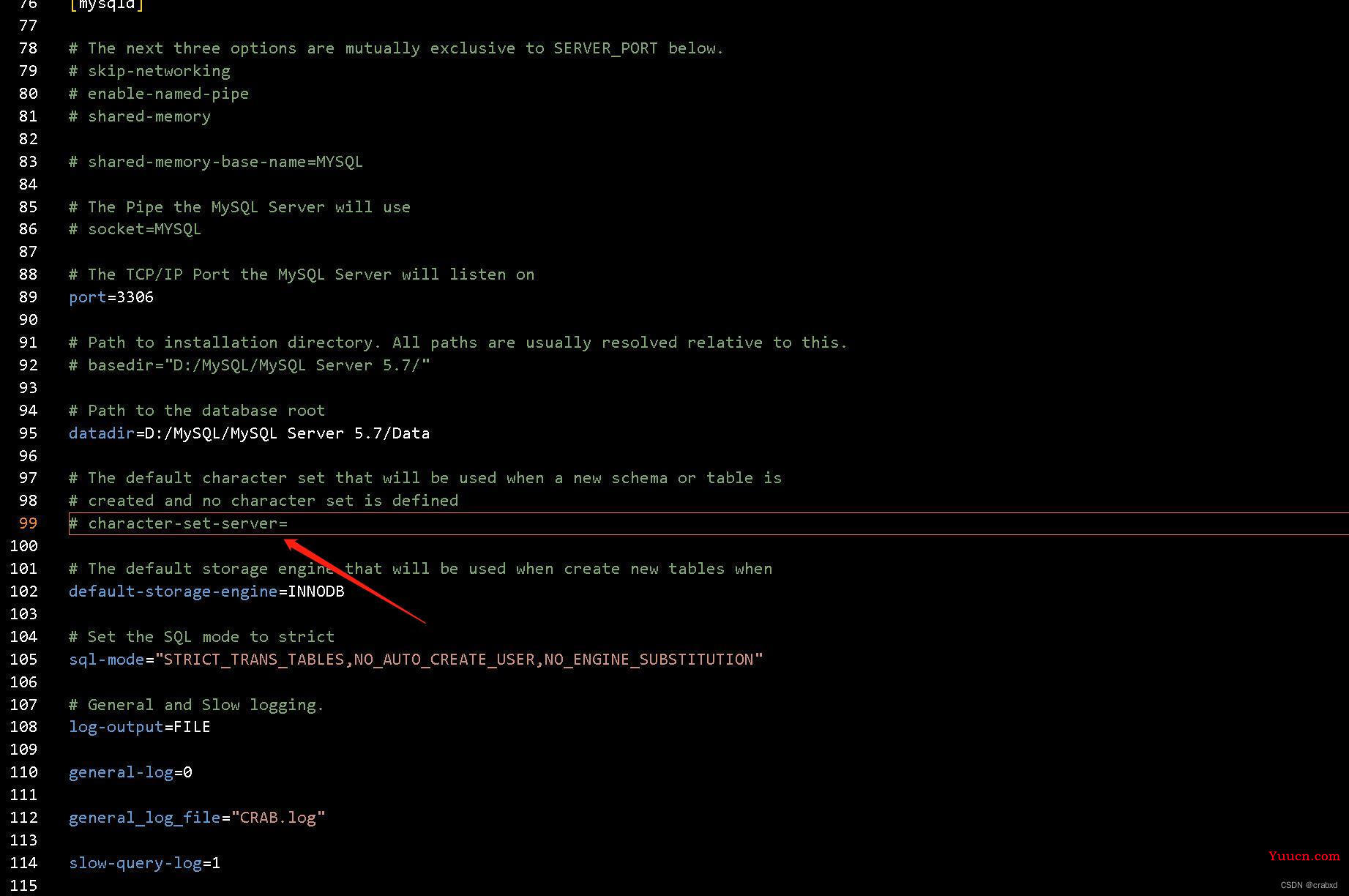
将其改为utf8,并且记得去除'#'号,否则它不会生效。
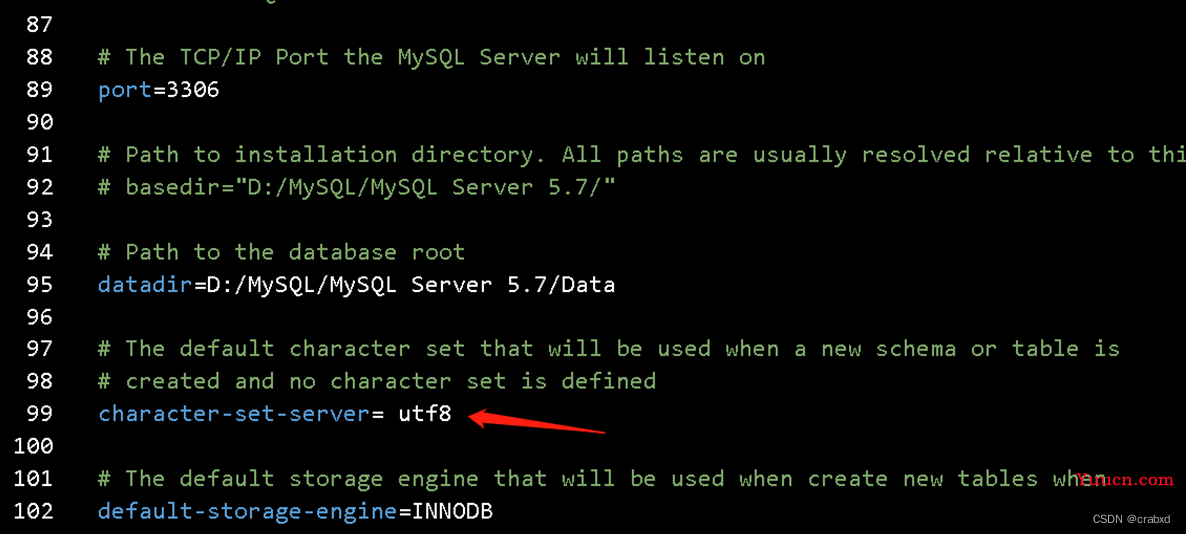
修改后保存文件,重启服务。
通过win+x快捷键或者右击开始栏,找到“计算机管理”这一选项,点击“服务和应用程序”->“服务”,找到MySQL对应的服务将其重启,如图16所示。

再次插入记录,此时不再出现乱码了,如下图所示。
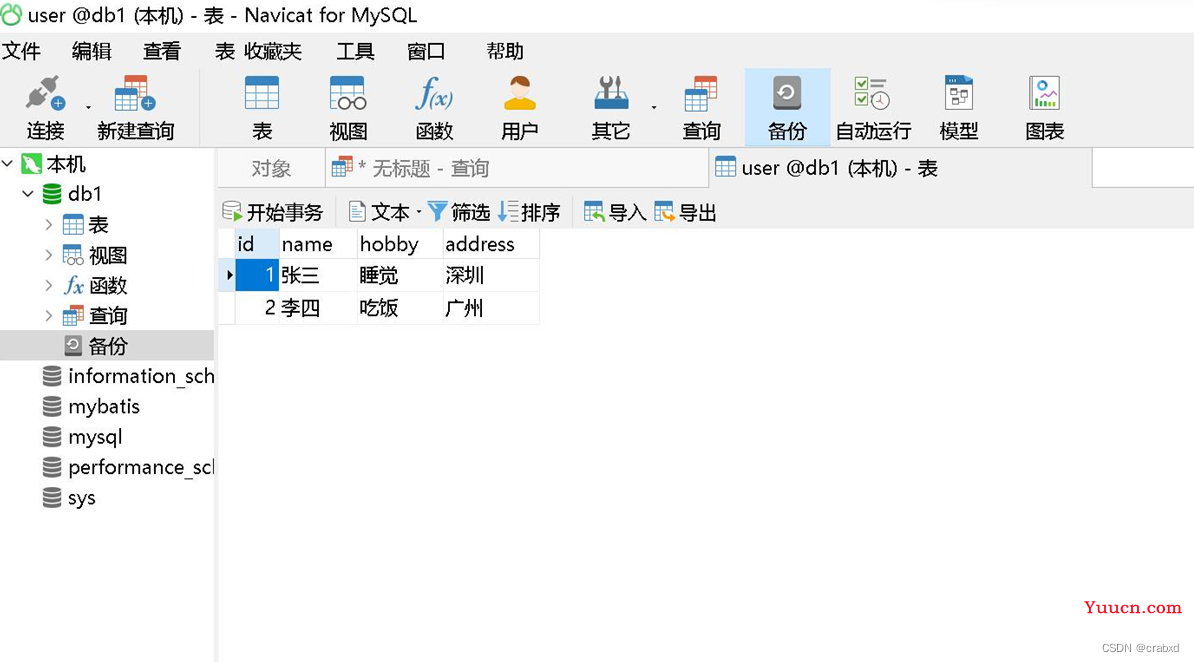
问题解决。
不过在网上查阅相应资料的时候,发现有些朋友在其MySQL的安装文件夹中并没有my.ini文件,所以可以新建一个my.ini文件,将下列内容拷贝进该文件中。
# Other default tuning values
# MySQL Server Instance Configuration File
# ----------------------------------------------------------------------
# Generated by the MySQL Server Instance Configuration Wizard
#
#
# Installation Instructions
# ----------------------------------------------------------------------
#
# On Linux you can copy this file to /etc/my.cnf to set global options,
# mysql-data-dir/my.cnf to set server-specific options
# (@localstatedir@ for this installation) or to
# ~/.my.cnf to set user-specific options.
#
# On Windows you should keep this file in the installation directory
# of your server (e.g. C:\Program Files\MySQL\MySQL Server X.Y). To
# make sure the server reads the config file use the startup option
# "--defaults-file".
#
# To run the server from the command line, execute this in a
# command line shell, e.g.
# mysqld --defaults-file="C:\Program Files\MySQL\MySQL Server X.Y\my.ini"
#
# To install the server as a Windows service manually, execute this in a
# command line shell, e.g.
# mysqld --install MySQLXY --defaults-file="C:\Program Files\MySQL\MySQL Server X.Y\my.ini"
#
# And then execute this in a command line shell to start the server, e.g.
# net start MySQLXY
#
#
# Guidelines for editing this file
# ----------------------------------------------------------------------
#
# In this file, you can use all long options that the program supports.
# If you want to know the options a program supports, start the program
# with the "--help" option.
#
# More detailed information about the individual options can also be
# found in the manual.
#
# For advice on how to change settings please see
# http://dev.mysql.com/doc/refman/5.7/en/server-configuration-defaults.html
#
#
# CLIENT SECTION
# ----------------------------------------------------------------------
#
# The following options will be read by MySQL client applications.
# Note that only client applications shipped by MySQL are guaranteed
# to read this section. If you want your own MySQL client program to
# honor these values, you need to specify it as an option during the
# MySQL client library initialization.
#
[client]
# pipe=
# socket=MYSQL
port=3306
[mysql]
no-beep
# default-character-set=
# SERVER SECTION
# ----------------------------------------------------------------------
#
# The following options will be read by the MySQL Server. Make sure that
# you have installed the server correctly (see above) so it reads this
# file.
#
# server_type=3
[mysqld]
# The next three options are mutually exclusive to SERVER_PORT below.
# skip-networking
# enable-named-pipe
# shared-memory
# shared-memory-base-name=MYSQL
# The Pipe the MySQL Server will use
# socket=MYSQL
# The TCP/IP Port the MySQL Server will listen on
port=3306
# Path to installation directory. All paths are usually resolved relative to this.
# basedir="D:/MySQL/MySQL Server 5.7/"
# Path to the database root
datadir=D:/MySQL/MySQL Server 5.7/Data
# The default character set that will be used when a new schema or table is
# created and no character set is defined
character-set-server= utf8
# The default storage engine that will be used when create new tables when
default-storage-engine=INNODB
# Set the SQL mode to strict
sql-mode="STRICT_TRANS_TABLES,NO_AUTO_CREATE_USER,NO_ENGINE_SUBSTITUTION"
# General and Slow logging.
log-output=FILE
general-log=0
general_log_file="CRAB.log"
slow-query-log=1
slow_query_log_file="CRAB-slow.log"
long_query_time=10
# Binary Logging.
# log-bin
# Error Logging.
log-error="CRAB.err"
# Server Id.
server-id=1
# Specifies the on how table names are stored in the metadata.
# If set to 0, will throw an error on case-insensitive operative systems
# If set to 1, table names are stored in lowercase on disk and comparisons are not case sensitive.
# If set to 2, table names are stored as given but compared in lowercase.
# This option also applies to database names and table aliases.
lower_case_table_names=1
# Secure File Priv.
secure-file-priv="C:/ProgramData/MySQL/MySQL Server 5.7/Uploads"
# The maximum amount of concurrent sessions the MySQL server will
# allow. One of these connections will be reserved for a user with
# SUPER privileges to allow the administrator to login even if the
# connection limit has been reached.
max_connections=151
# The number of open tables for all threads. Increasing this value
# increases the number of file descriptors that mysqld requires.
# Therefore you have to make sure to set the amount of open files
# allowed to at least 4096 in the variable "open-files-limit" in
# section [mysqld_safe]
table_open_cache=2000
# Maximum size for internal (in-memory) temporary tables. If a table
# grows larger than this value, it is automatically converted to disk
# based table This limitation is for a single table. There can be many
# of them.
tmp_table_size=85M
# How many threads we should keep in a cache for reuse. When a client
# disconnects, the client's threads are put in the cache if there aren't
# more than thread_cache_size threads from before. This greatly reduces
# the amount of thread creations needed if you have a lot of new
# connections. (Normally this doesn't give a notable performance
# improvement if you have a good thread implementation.)
thread_cache_size=10
#*** MyISAM Specific options
# The maximum size of the temporary file MySQL is allowed to use while
# recreating the index (during REPAIR, ALTER TABLE or LOAD DATA INFILE.
# If the file-size would be bigger than this, the index will be created
# through the key cache (which is slower).
myisam_max_sort_file_size=100G
# If the temporary file used for fast index creation would be bigger
# than using the key cache by the amount specified here, then prefer the
# key cache method. This is mainly used to force long character keys in
# large tables to use the slower key cache method to create the index.
myisam_sort_buffer_size=161M
# Size of the Key Buffer, used to cache index blocks for MyISAM tables.
# Do not set it larger than 30% of your available memory, as some memory
# is also required by the OS to cache rows. Even if you're not using
# MyISAM tables, you should still set it to 8-64M as it will also be
# used for internal temporary disk tables.
key_buffer_size=8M
# Size of the buffer used for doing full table scans of MyISAM tables.
# Allocated per thread, if a full scan is needed.
read_buffer_size=64K
read_rnd_buffer_size=256K
#*** INNODB Specific options ***
# innodb_data_home_dir=
# Use this option if you have a MySQL server with InnoDB support enabled
# but you do not plan to use it. This will save memory and disk space
# and speed up some things.
# skip-innodb
# If set to 1, InnoDB will flush (fsync) the transaction logs to the
# disk at each commit, which offers full ACID behavior. If you are
# willing to compromise this safety, and you are running small
# transactions, you may set this to 0 or 2 to reduce disk I/O to the
# logs. Value 0 means that the log is only written to the log file and
# the log file flushed to disk approximately once per second. Value 2
# means the log is written to the log file at each commit, but the log
# file is only flushed to disk approximately once per second.
innodb_flush_log_at_trx_commit=1
# The size of the buffer InnoDB uses for buffering log data. As soon as
# it is full, InnoDB will have to flush it to disk. As it is flushed
# once per second anyway, it does not make sense to have it very large
# (even with long transactions).
innodb_log_buffer_size=1M
# InnoDB, unlike MyISAM, uses a buffer pool to cache both indexes and
# row data. The bigger you set this the less disk I/O is needed to
# access data in tables. On a dedicated database server you may set this
# parameter up to 80% of the machine physical memory size. Do not set it
# too large, though, because competition of the physical memory may
# cause paging in the operating system. Note that on 32bit systems you
# might be limited to 2-3.5G of user level memory per process, so do not
# set it too high.
innodb_buffer_pool_size=8M
# Size of each log file in a log group. You should set the combined size
# of log files to about 25%-100% of your buffer pool size to avoid
# unneeded buffer pool flush activity on log file overwrite. However,
# note that a larger logfile size will increase the time needed for the
# recovery process.
innodb_log_file_size=48M
# Number of threads allowed inside the InnoDB kernel. The optimal value
# depends highly on the application, hardware as well as the OS
# scheduler properties. A too high value may lead to thread thrashing.
innodb_thread_concurrency=33
# The increment size (in MB) for extending the size of an auto-extend InnoDB system tablespace file when it becomes full.
innodb_autoextend_increment=64
# The number of regions that the InnoDB buffer pool is divided into.
# For systems with buffer pools in the multi-gigabyte range, dividing the buffer pool into separate instances can improve concurrency,
# by reducing contention as different threads read and write to cached pages.
innodb_buffer_pool_instances=8
# Determines the number of threads that can enter InnoDB concurrently.
innodb_concurrency_tickets=5000
# Specifies how long in milliseconds (ms) a block inserted into the old sublist must stay there after its first access before
# it can be moved to the new sublist.
innodb_old_blocks_time=1000
# It specifies the maximum number of .ibd files that MySQL can keep open at one time. The minimum value is 10.
innodb_open_files=300
# When this variable is enabled, InnoDB updates statistics during metadata statements.
innodb_stats_on_metadata=0
# When innodb_file_per_table is enabled (the default in 5.6.6 and higher), InnoDB stores the data and indexes for each newly created table
# in a separate .ibd file, rather than in the system tablespace.
innodb_file_per_table=1
# Use the following list of values: 0 for crc32, 1 for strict_crc32, 2 for innodb, 3 for strict_innodb, 4 for none, 5 for strict_none.
innodb_checksum_algorithm=0
# The number of outstanding connection requests MySQL can have.
# This option is useful when the main MySQL thread gets many connection requests in a very short time.
# It then takes some time (although very little) for the main thread to check the connection and start a new thread.
# The back_log value indicates how many requests can be stacked during this short time before MySQL momentarily
# stops answering new requests.
# You need to increase this only if you expect a large number of connections in a short period of time.
back_log=80
# If this is set to a nonzero value, all tables are closed every flush_time seconds to free up resources and
# synchronize unflushed data to disk.
# This option is best used only on systems with minimal resources.
flush_time=0
# The minimum size of the buffer that is used for plain index scans, range index scans, and joins that do not use
# indexes and thus perform full table scans.
join_buffer_size=256K
# The maximum size of one packet or any generated or intermediate string, or any parameter sent by the
# mysql_stmt_send_long_data() C API function.
max_allowed_packet=4M
# If more than this many successive connection requests from a host are interrupted without a successful connection,
# the server blocks that host from performing further connections.
max_connect_errors=100
# Changes the number of file descriptors available to mysqld.
# You should try increasing the value of this option if mysqld gives you the error "Too many open files".
open_files_limit=4161
# If you see many sort_merge_passes per second in SHOW GLOBAL STATUS output, you can consider increasing the
# sort_buffer_size value to speed up ORDER BY or GROUP BY operations that cannot be improved with query optimization
# or improved indexing.
sort_buffer_size=256K
# The number of table definitions (from .frm files) that can be stored in the definition cache.
# If you use a large number of tables, you can create a large table definition cache to speed up opening of tables.
# The table definition cache takes less space and does not use file descriptors, unlike the normal table cache.
# The minimum and default values are both 400.
table_definition_cache=1400
# Specify the maximum size of a row-based binary log event, in bytes.
# Rows are grouped into events smaller than this size if possible. The value should be a multiple of 256.
binlog_row_event_max_size=8K
# If the value of this variable is greater than 0, a replication slave synchronizes its master.info file to disk.
# (using fdatasync()) after every sync_master_info events.
sync_master_info=10000
# If the value of this variable is greater than 0, the MySQL server synchronizes its relay log to disk.
# (using fdatasync()) after every sync_relay_log writes to the relay log.
sync_relay_log=10000
# If the value of this variable is greater than 0, a replication slave synchronizes its relay-log.info file to disk.
# (using fdatasync()) after every sync_relay_log_info transactions.
sync_relay_log_info=10000
# Load mysql plugins at start."plugin_x ; plugin_y".
# plugin_load
# The TCP/IP Port the MySQL Server X Protocol will listen on.
# loose_mysqlx_port=33060
但单纯复制添加了该文件还不行,此时mysql的注册表中的路径指向的并不是我们刚刚创建的那个my.ini。
win+r,输入regedit查看注册表,如图所示。

找路径:
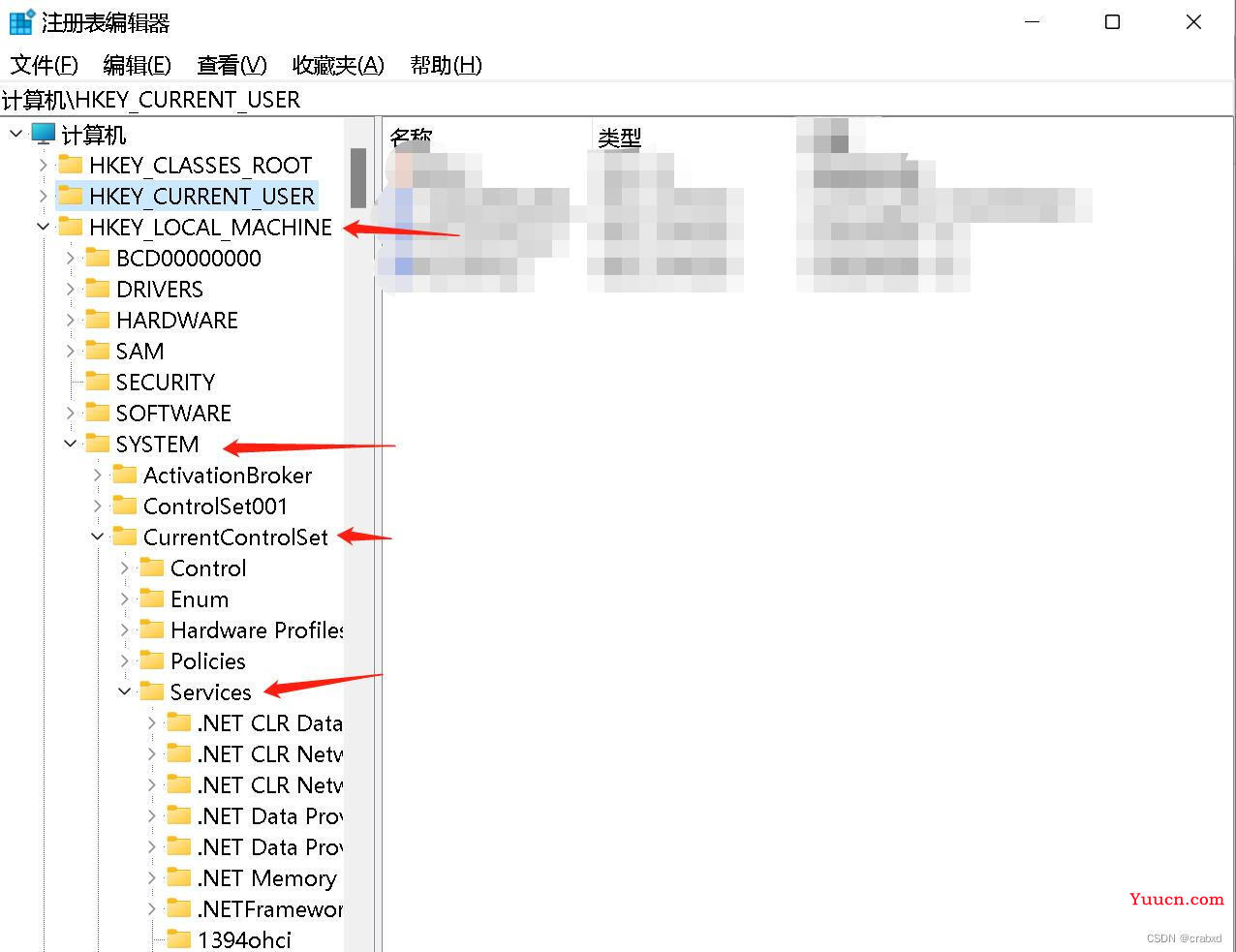

修改ImagePath路径,修改为我们所创建的my.ini便可以了。
参考资料
java向Mysql数据库添加中文数据,在数据库显示乱码
关于mysql修改character_set_server = utf8不生效的问题